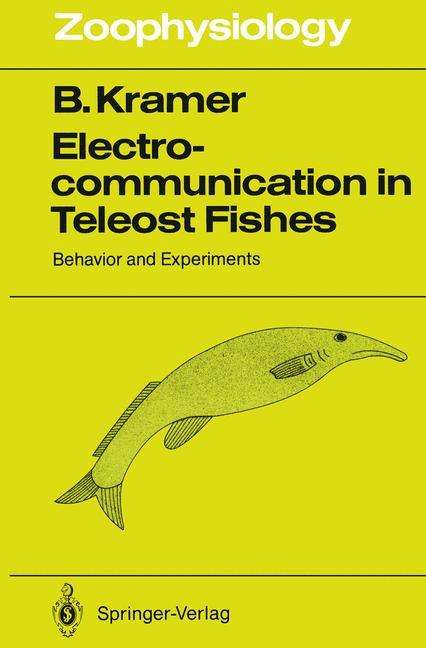Bernd Kramer: Electrocommunication in Teleost Fishes, Kartoniert / Broschiert
Electrocommunication in Teleost Fishes
Buch
- Behavior and Experiments
lieferbar innerhalb 2-3 Wochen
(soweit verfügbar beim Lieferanten)
(soweit verfügbar beim Lieferanten)
EUR 120,46**
EUR 109,51*
- Verlag:
- Springer Berlin Heidelberg, 12/2011
- Einband:
- Kartoniert / Broschiert, Paperback
- Sprache:
- Englisch
- ISBN-13:
- 9783642840289
- Artikelnummer:
- 3020313
- Umfang:
- 256 Seiten
- Sonstiges:
- 26 SW-Abb., 12 Tabellen,
- Ausgabe:
- Softcover reprint of the original 1st ed. 1990
- Copyright-Jahr:
- 2012
- Gewicht:
- 392 g
- Maße:
- 235 x 155 mm
- Stärke:
- 13 mm
- Erscheinungstermin:
- 8.12.2011
- Serie:
- Zoophysiology - Band 29
- Hinweis
-
Achtung: Artikel ist nicht in deutscher Sprache!
Inhaltsangabe
1. Taxonomy of Electroreceptive Teleosts.- 1.1 Osteoglossiformes.- 1.2 Mormyriformes.- 1.3 Gymnotiformes.- 1.4 Siluriformes.- 2. Electric Sensori-Motor System.- 2.1 Electroreception in Evolutionary Perspective.- 2.1.1 Cranial Nerves and Somatic Distribution of Electroreceptors in Teleosts.- 2.1.2 Structure of Electroreceptors in Teleosts.- 2.1.3 Modes of Encoding Electrical Stimuli.- 2.1.4 Central Projections of Electroreceptive Afferents (Mormyridae, Gymnotiformes).- 2.2 Electric Organs.- 2.2.1 Structure and Function of Electric Organs.- 2.2.2 Neural Control of Electric Organs.- 2.3 The Electric System in the Aquatic Environment.- 2.3.1 Active Electrolocation.- 2.3.2 Electrocommunication: Spatial Aspects of Sending and Receiving Electric Organ Discharges.- 3. Species Diversity of Electric Organ Discharge Activity.- 3.1 Waveforms of Electric Organ Discharges.- 3.1.1 Mormyriformes.- 3.1.1.1 Mormyriform Pulse Species (Mormyridae).- 3.1.1.2 Mormyriform Wave Species (Gymnarchus).- 3.1.2 Gymnotiformes.- 3.1.2.1 Gymnotiform Pulse Species.- 3.1.2.2 Gymnotiform Wave Species.- 3.1.3 Siluriformes.- 3.2 Patterns of Spontaneous Discharge Rates.- 3.2.1 Mormyriformes.- 3.2.1.1 Mormyriform Pulse Species (Mormyridae).- 3.2.1.2 Mormyriform Wave Species (Gymnarchus).- 3.2.2 Gymnotiformes.- 3.2.2.1 Gymnotiform Pulse Species.- 3.2.2.2 Gymnotiform Wave Species.- 3.2.3 Siluriformes.- 3.3 Responses to Disturbances (or Food Stimuli).- 3.3.1 Mormyriformes.- 3.3.1.1 Mormyriform Pulse Species (Mormyridae).- 3.3.1.2 Mormyriform Wave Species (Gymnarchus).- 3.3.2 Gymnotiformes.- 3.3.2.1 Gymnotiform Pulse Species.- 3.3.2.2 Gymnotiform Wave Species.- 3.3.3 Siluriformes.- 4. Communicating with Electric Organ Discharges.- 4.1 Electrical and Motor Displays of Communicating Fish.- 4.1.1 Mormyriformes.- 4.1.1.1 Mormyriform Pulse Species (Mormyridae).- 4.1.1.2 Mormyriform Wave Species (Gymnarchus).- 4.1.2 Gymnotiformes.- 4.1.2.1 Gymnotiform Pulse Species.- 4.1.2.2 Gymnotiform Wave Species.- 4.2 Experimental Manipulation of the Electrocommunication System.- 4.2.1 Mormyriformes.- 4.2.1.1 Ethological Approach.- 4.2.1.2 Playback of EOD Interval Patterns.- 4.2.1.3 Species Recognition by EOD Interval Pattern (B. Kramer and H. Lücker).- 4.2.1.4 Discrimination of Inter-Pulse Intervals (B. Kramer and U. Heinrich).- 4.2.2 Gymnotiformes.- 4.2.2.1 Electrical Stimulation and Playback of EOD Patterns in Pulse Species.- 4.2.2.2 Electrical Stimulation and Playback of EODs in Wave Species.- Conclusion.- References.- Systematic Index.Klappentext
Some fishes test their environment by generating electric fields outside their bodies (man's first contact with electricity). To send and receive electric signals, one's own or those from a neighbor, is the basis of some bony fishes' unusual sensory capacities that enable them to lead a secret, nocturnal life. This volume provides the reader with a detailed account of these fishes' biology and behavior and their sophisticated sensory capacities. The phylogenetic relationships of the fish taxa involved are discussed as well as the physiology and anatomy of the electrosensory-motor-system and the integration to form an efficient intelligence system. The main emphasis is on the descriptive and experimental analysis of electric communication behavior in a variety of species, including studies of digital signal synthesis. Whenever possible, mechanisms of communication are indicated.Biografie
Bernd Kramer, Jahrgang 1984, studierte Volkswirtschaftslehre, Soziologie und Politik an der Universität Köln und war Absolvent der Kölner Journalistenschule. Er schreibt als Journalist unter anderem für die taz, Spiegel online, Süddeutsche Zeitung, Neon und die ZEIT und arbeitete undercover bei einer Astro-Hotline und auf Esoterik-Messen.
Bernd Kramer
Electrocommunication in Teleost Fishes
EUR 120,46**
EUR 109,51*

